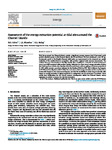Assessment of the energy extraction potential at tidal sites around the Channel Islands
| dc.contributor.author | Coles, Danny | |
| dc.contributor.author | Blunden, LS | |
| dc.contributor.author | Bahaj, AS | |
| dc.date.accessioned | 2023-02-14T11:15:11Z | |
| dc.date.available | 2023-02-14T11:15:11Z | |
| dc.date.issued | 2017-04-01 | |
| dc.identifier.issn | 0360-5442 | |
| dc.identifier.issn | 1873-6785 | |
| dc.identifier.uri | http://hdl.handle.net/10026.1/20338 | |
| dc.description.abstract |
Tidal flows around the Channel Islands contain a significant energy resource that if harnessed could provide electrical power to the Channel Islands, the UK and France. We have developed a new 2D hydrodynamic model of the English Channel which gives an improvement to the temporal and spatial resolution of the ambient flow in comparison with previous regional scale resource assessments. The ambient flow was characterised to identify suitable sites, resulting in a reduction in total development area of up to 80% compared with previous studies. Estimates for upper bound energy extraction confirm that Alderney Race contains the majority of the Channel Islands resource, giving a maximum potential of 5.1 GW, which exceeds a previous estimate for the Pentland Firth by 35%. This is followed by Casquets (0.47 GW) and then Big Roussel (0.24 GW). Our work shows that energy extraction at Alderney Race has a constructive impact on the resource at Casquets, and that the sensitivity to added drag at each site with respect to energy extraction is highly dependent on bathymetry and the proximity of coastlines. These results have implications for the overall resource development within the Channel Islands, where regulation is needed to account for site-site interaction. | |
| dc.format.extent | 171-186 | |
| dc.language | en | |
| dc.language.iso | en | |
| dc.publisher | Elsevier BV | |
| dc.subject | Tidal power | |
| dc.subject | Marine currents | |
| dc.subject | Alderney Race | |
| dc.subject | Casquets | |
| dc.subject | Big Roussel | |
| dc.subject | Channel Islands | |
| dc.title | Assessment of the energy extraction potential at tidal sites around the Channel Islands | |
| dc.type | journal-article | |
| dc.type | Journal Article | |
| plymouth.author-url | https://www.webofscience.com/api/gateway?GWVersion=2&SrcApp=PARTNER_APP&SrcAuth=LinksAMR&KeyUT=WOS:000399269300016&DestLinkType=FullRecord&DestApp=ALL_WOS&UsrCustomerID=11bb513d99f797142bcfeffcc58ea008 | |
| plymouth.volume | 124 | |
| plymouth.publication-status | Published | |
| plymouth.journal | Energy | |
| dc.identifier.doi | 10.1016/j.energy.2017.02.023 | |
| plymouth.organisational-group | /Plymouth | |
| plymouth.organisational-group | /Plymouth/Faculty of Science and Engineering | |
| plymouth.organisational-group | /Plymouth/Faculty of Science and Engineering/School of Engineering, Computing and Mathematics | |
| plymouth.organisational-group | /Plymouth/Users by role | |
| plymouth.organisational-group | /Plymouth/Users by role/Academics | |
| dcterms.dateAccepted | 2017-02-05 | |
| dc.rights.embargodate | 2023-2-15 | |
| dc.identifier.eissn | 1873-6785 | |
| dc.rights.embargoperiod | Not known | |
| rioxxterms.versionofrecord | 10.1016/j.energy.2017.02.023 | |
| rioxxterms.licenseref.uri | http://www.rioxx.net/licenses/all-rights-reserved | |
| rioxxterms.type | Journal Article/Review |


